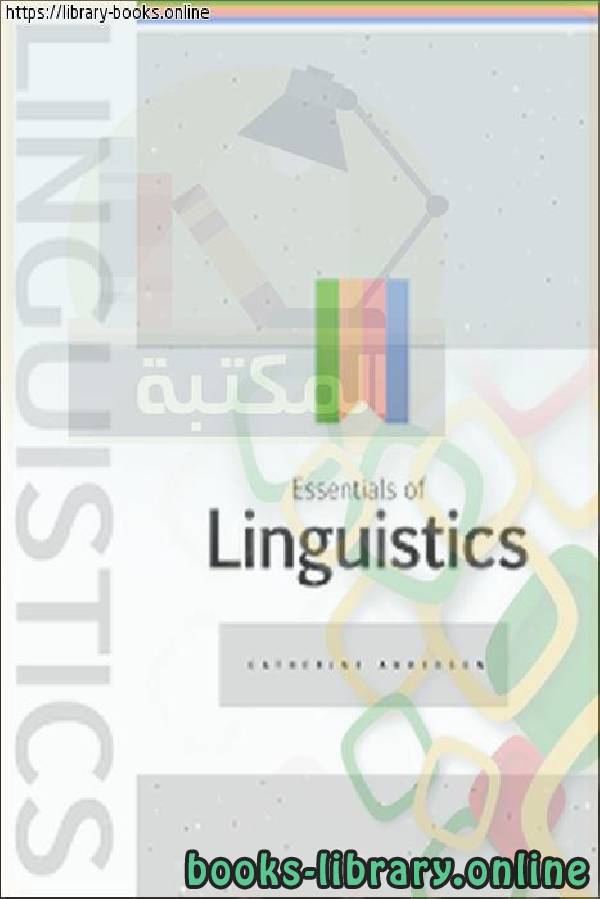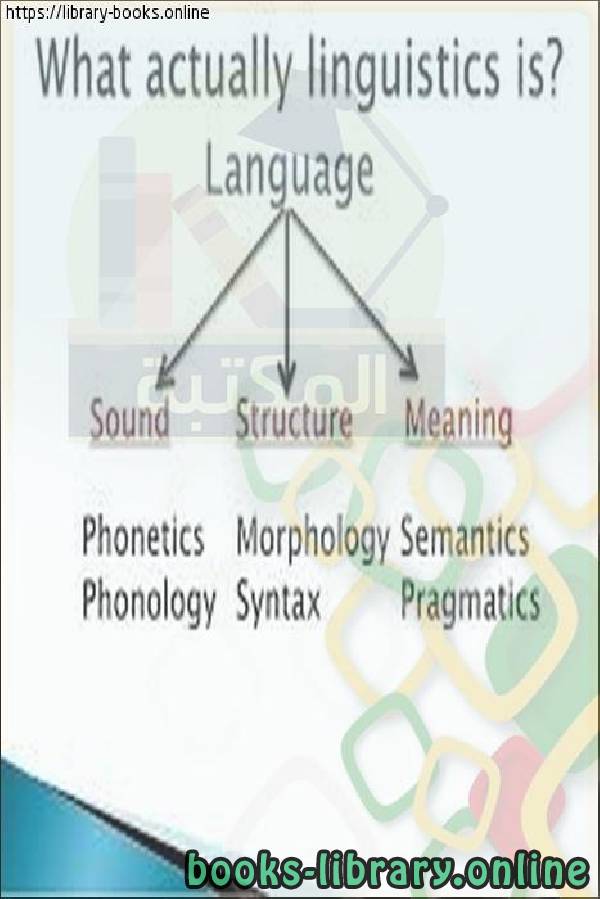كتاب Essentials of Linguistics - SOL*R
Essentials of Linguistics - SOL*R Essentials of Linguistics by Catherine Anderson is licensed under a Creative Commons Attribution-ShareAlike 4.0 International License, except where otherwise noted. Contents About the Book 1 About the Author 3 Acknowledgements 5 Part I. Chapter 1: Thinking Like a Linguist 1. 1.1 Linguistics is Science 9 2. 1.2 Mental Grammar 14 3. 1.3 Creativity and Generativity 19 4. 1.4 Fundamental Properties of Language 24 5. Practice Time 31 6. Summary 33 Part II. Chapter 2: Producing Speech Sounds 7. 2.1 How Humans Produce Speech 37 8. 2.2 Articulators 43 9. 2.3 Describing Speech Sounds: the IPA 48 10. 2.4 IPA symbols and speech sounds 54 11. 2.5 Sonority, Consonants, and Vowels 58 12. 2.6 Classifying Consonants 62 13. 2.7 Classifying Vowels 68 14. 2.8 Diphthongs 73 Part III. Chapter 3: Transcribing Speech Sounds 18. 3.1 Broad and Narrow Transcription 89 19. 3.2 IPA for Canadian English 91 20. 3.3 Syllabic Consonants 94 21. 3.4 Aspirated Stops in English 98 22. 3.5 Articulatory Processes: Assimilation 104 23. 3.6 Other Articulatory Processes 108 24. 3.7 Suprasegmentals 112 25. 3.8 Transcribing Casual Speech 117 26. Practice Time 123 27. Summary 125 Part IV. Chapter 4: Speech Sounds in the Mind 28. 4.1 Phonemes and Contrast 129 29. 4.2 Allophones and Predictable Variation 135 30. 4.3 Phonetic Segments and Features 140 31. 4.4 Natural Classes 145 32. 4.5 Phonological Derivations 154 33. Practice Time 160 34. Summary 163 Part V. Chapter 5: Psycholinguistics of Learning Sounds 35. 5.1 How Babies Learn the Phoneme Categories of Their Language 167 36. 5.2 How Adults Learn the Phoneme Categories in a New Language 173 37. Practice Time 178 38. Summary 179 Part VI. Chapter 6: Word Forms 39. 6.1 Words and Morphemes 183 40. 6.2 Allomorphs 187 41. 6.3 Inflectional Morphology 189 42. 6.4 Derivational Morphology 194 43. 6.5 Inflectional Morphology in Some Indigenous Languages 199 44. Practice Time 204 45. Summary 206 Part VII. Chapter 7: Combining Words 46. 7.1 Nouns, Verbs and Adjectives: Open Class Categories 209 47. 7.2 Compound Words 214 48. 7.3 Closed Class Categories (Function Words) 219 49. 7.4 Auxiliaries 222 50. 7.5 Neurolinguistics: Syntactic Category Differences in the Brain 224 51. Practice Time 229 52. Summary 231 Part VIII. Chapter 8: Forming Sentences 53.Catherine Anderson - ❰ له مجموعة من الإنجازات والمؤلفات أبرزها ❞ Essentials of Linguistics - SOL*R ❝ ❱
من اللغويات Linguistics كتب تعلم اللغة الإنجليزية - مكتبة كتب تعلم اللغات.

قراءة كتاب Essentials of Linguistics - SOL*R أونلاين
معلومات عن كتاب Essentials of Linguistics - SOL*R:
Essentials of Linguistics by Catherine Anderson is licensed under a Creative Commons
Attribution-ShareAlike 4.0 International License, except where otherwise noted.
Contents
About the Book 1
About the Author 3
Acknowledgements 5
Part I. Chapter 1: Thinking Like a Linguist
1. 1.1 Linguistics is Science 9
2. 1.2 Mental Grammar 14
3. 1.3 Creativity and Generativity 19
4. 1.4 Fundamental Properties of Language 24
5. Practice Time 31
6. Summary 33
Part II. Chapter 2: Producing Speech Sounds
7. 2.1 How Humans Produce Speech 37
8. 2.2 Articulators 43
9. 2.3 Describing Speech Sounds: the IPA 48
10. 2.4 IPA symbols and speech sounds 54
11. 2.5 Sonority, Consonants, and Vowels 58
12. 2.6 Classifying Consonants 62
13. 2.7 Classifying Vowels 68
14. 2.8 Diphthongs 73
Part III. Chapter 3: Transcribing Speech Sounds
18. 3.1 Broad and Narrow Transcription 89
19. 3.2 IPA for Canadian English 91
20. 3.3 Syllabic Consonants 94
21. 3.4 Aspirated Stops in English 98
22. 3.5 Articulatory Processes: Assimilation 104
23. 3.6 Other Articulatory Processes 108
24. 3.7 Suprasegmentals 112
25. 3.8 Transcribing Casual Speech 117
26. Practice Time 123
27. Summary 125
Part IV. Chapter 4: Speech Sounds in the Mind
28. 4.1 Phonemes and Contrast 129
29. 4.2 Allophones and Predictable Variation 135
30. 4.3 Phonetic Segments and Features 140
31. 4.4 Natural Classes 145
32. 4.5 Phonological Derivations 154
33. Practice Time 160
34. Summary 163
Part V. Chapter 5: Psycholinguistics of Learning
Sounds
35. 5.1 How Babies Learn the Phoneme Categories of
Their Language
167
36. 5.2 How Adults Learn the Phoneme Categories in a
New Language
173
37. Practice Time 178
38. Summary 179
Part VI. Chapter 6: Word Forms
39. 6.1 Words and Morphemes 183
40. 6.2 Allomorphs 187
41. 6.3 Inflectional Morphology 189
42. 6.4 Derivational Morphology 194
43. 6.5 Inflectional Morphology in Some Indigenous
Languages
199
44. Practice Time 204
45. Summary 206
Part VII. Chapter 7: Combining Words
46. 7.1 Nouns, Verbs and Adjectives: Open Class
Categories
209
47. 7.2 Compound Words 214
48. 7.3 Closed Class Categories (Function Words) 219
49. 7.4 Auxiliaries 222
50. 7.5 Neurolinguistics: Syntactic Category Differences
in the Brain
224
51. Practice Time 229
52. Summary 231
Part VIII. Chapter 8: Forming Sentences
53.
سنة النشر : 2017م / 1438هـ .
عدد مرات التحميل : 7189 مرّة / مرات.
تم اضافته في : الخميس , 26 ديسمبر 2019م.
حجم الكتاب عند التحميل : 3.5MB .
تعليقات ومناقشات حول الكتاب:
هذا يحتوي يحتوى علي معلومات خاصة بعلم اللغويات
هي علم يهتم بدراسة اللغات الإنسانية ودراسة خصائصها وتراكيبها ودرجات التشابه والتباين فيما بينها.و يدرس اللغة من كل جوانبها دراسة شاملة.
أما اللغوي فهو الشخص الذي يقوم بهذه الدراسة. ظهرت اللسانيات الحديثة في القرن 19م، لكنها كعلم قديمة قدم الإنسان. جاءت بفكرة رئيسة مع العالم فرديناند دو سوسور فمع علمنة الثورة الصناعية أراد علمنة اللغة أيضا في كتابه /محاضرات في اللسانيات العامة/ فاللغة عنده تحمل هويات من قيم الدين، والمحيط، والثقافة، والفكر الفلسفي.
Linguistics is the scientific study of language. It involves analysing language form, language meaning, and language in context. The earliest activities in the documentation and description of language have been attributed to the 6th-century-BC Indian grammarian Pāṇini who wrote a formal description of the Sanskrit language in his Aṣṭādhyāyī.[5]
Linguists traditionally analyse human language by observing an interplay between sound and meaning. Phonetics is the study of speech and non-speech sounds, and delves into their acoustic and articulatory properties. The study of language meaning, on the other hand, deals with how languages encode relations between entities, properties, and other aspects of the world to convey, process, and assign meaning, as well as manage and resolve ambiguity. While the study of semantics typically concerns itself with truth conditions, pragmatics deals with how situational context influences the production of meaning
Grammar is a system of rules which governs the production and use of utterances in a given language. These rules apply to sound as well as meaning, and include componential subsets of rules, such as those pertaining to phonology (the organisation of phonetic sound systems), morphology (the formation and composition of words), and syntax (the formation and composition of phrases and sentences). Many modern theories that deal with the principles of grammar are based on Noam Chomsky's framework of generative linguistics.]
In the early 20th century, Ferdinand de Saussure distinguished between the notions of langue and parole in his formulation of structural linguistics. According to him, parole is the specific utterance of speech, whereas langue refers to an abstract phenomenon that theoretically defines the principles and system of rules that govern a language. This distinction resembles the one made by Noam Chomsky between competence and performance in his theory of transformative or generative grammar. According to Chomsky, competence is an individual's innate capacity and potential for language (like in Saussure's langue), while performance is the specific way in which it is used by individuals, groups, and communities (i.e., parole, in Saussurean term
Essentials of Linguistics - SOL*R
Essentials of Linguistics by Catherine Anderson is licensed under a Creative Commons
Attribution-ShareAlike 4.0 International License, except where otherwise noted.
Contents
About the Book 1
About the Author 3
Acknowledgements 5
Part I. Chapter 1: Thinking Like a Linguist
1. 1.1 Linguistics is Science 9
2. 1.2 Mental Grammar 14
3. 1.3 Creativity and Generativity 19
4. 1.4 Fundamental Properties of Language 24
5. Practice Time 31
6. Summary 33
Part II. Chapter 2: Producing Speech Sounds
7. 2.1 How Humans Produce Speech 37
8. 2.2 Articulators 43
9. 2.3 Describing Speech Sounds: the IPA 48
10. 2.4 IPA symbols and speech sounds 54
11. 2.5 Sonority, Consonants, and Vowels 58
12. 2.6 Classifying Consonants 62
13. 2.7 Classifying Vowels 68
14. 2.8 Diphthongs 73
Part III. Chapter 3: Transcribing Speech Sounds
18. 3.1 Broad and Narrow Transcription 89
19. 3.2 IPA for Canadian English 91
20. 3.3 Syllabic Consonants 94
21. 3.4 Aspirated Stops in English 98
22. 3.5 Articulatory Processes: Assimilation 104
23. 3.6 Other Articulatory Processes 108
24. 3.7 Suprasegmentals 112
25. 3.8 Transcribing Casual Speech 117
26. Practice Time 123
27. Summary 125
Part IV. Chapter 4: Speech Sounds in the Mind
28. 4.1 Phonemes and Contrast 129
29. 4.2 Allophones and Predictable Variation 135
30. 4.3 Phonetic Segments and Features 140
31. 4.4 Natural Classes 145
32. 4.5 Phonological Derivations 154
33. Practice Time 160
34. Summary 163
Part V. Chapter 5: Psycholinguistics of Learning
Sounds
35. 5.1 How Babies Learn the Phoneme Categories of
Their Language
167
36. 5.2 How Adults Learn the Phoneme Categories in a
New Language
173
37. Practice Time 178
38. Summary 179
Part VI. Chapter 6: Word Forms
39. 6.1 Words and Morphemes 183
40. 6.2 Allomorphs 187
41. 6.3 Inflectional Morphology 189
42. 6.4 Derivational Morphology 194
43. 6.5 Inflectional Morphology in Some Indigenous
Languages
199
44. Practice Time 204
45. Summary 206
Part VII. Chapter 7: Combining Words
46. 7.1 Nouns, Verbs and Adjectives: Open Class
Categories
209
47. 7.2 Compound Words 214
48. 7.3 Closed Class Categories (Function Words) 219
49. 7.4 Auxiliaries 222
50. 7.5 Neurolinguistics: Syntactic Category Differences
in the Brain
224
51. Practice Time 229
52. Summary 231
Part VIII. Chapter 8: Forming Sentences
53.
Introduction to Linguistics
introduction to linguistics pdf
branches of linguistics pdf
general linguistics pdf
linguistics pdf books free download
concept of linguistics
introduction to language
language in linguistics
schools of linguistics pdf
Linguistics
linguistics lessons
types of linguistics
what is linguistics pdf
purpose of linguistics
why study linguistics?
branches of linguistics
modern linguistics summary
characteristics of linguistics
 مهلاً !
مهلاً !قبل تحميل الكتاب .. يجب ان يتوفر لديكم برنامج تشغيل وقراءة ملفات pdf
يمكن تحميلة من هنا 'تحميل البرنامج'

نوع الكتاب : pdf.
اذا اعجبك الكتاب فضلاً اضغط على أعجبني و يمكنك تحميله من هنا:


كتب اخرى في اللغويات Linguistics
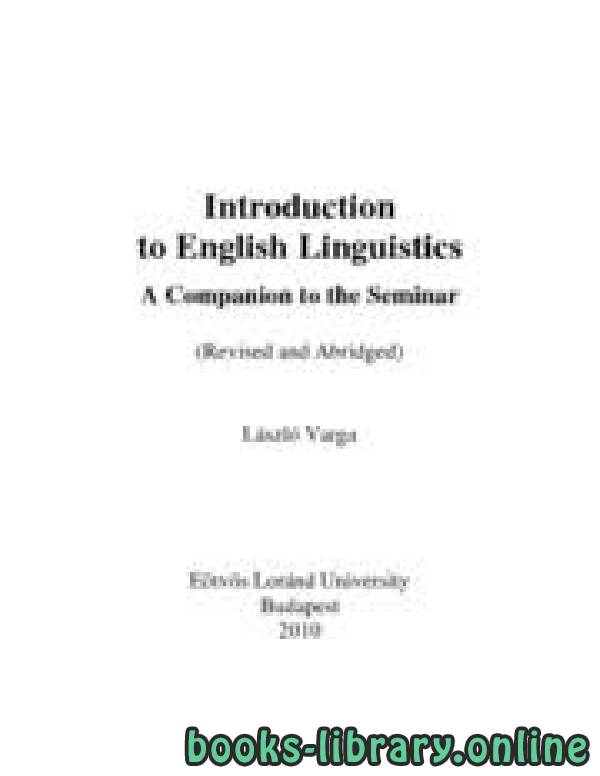
Introduction to English Linguistics A Companion to the Seminar (Revised and Abridged) PDF
قراءة و تحميل كتاب Introduction to English Linguistics A Companion to the Seminar (Revised and Abridged) PDF مجانا
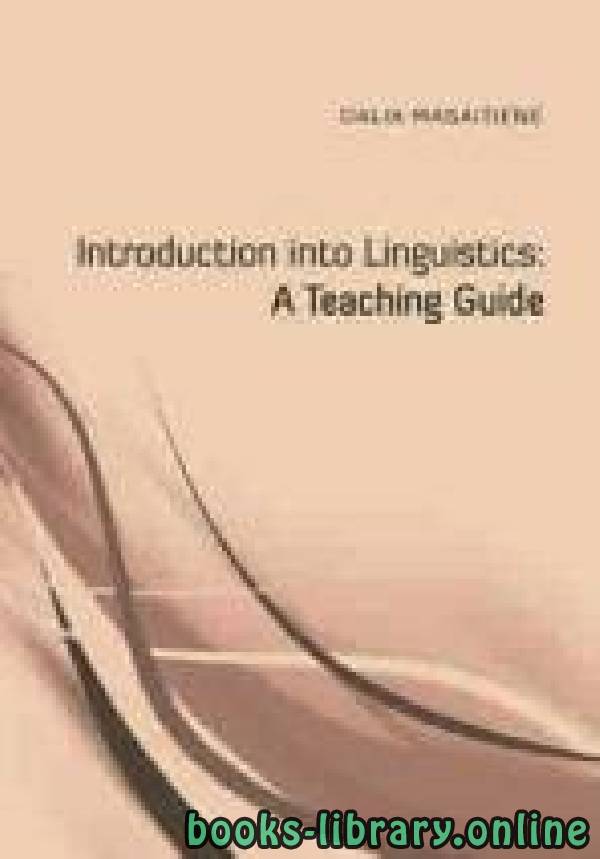
DALIA MASAITIENĖ Introduction into Linguistics: A Teaching Guide PDF
قراءة و تحميل كتاب DALIA MASAITIENĖ Introduction into Linguistics: A Teaching Guide PDF مجانا
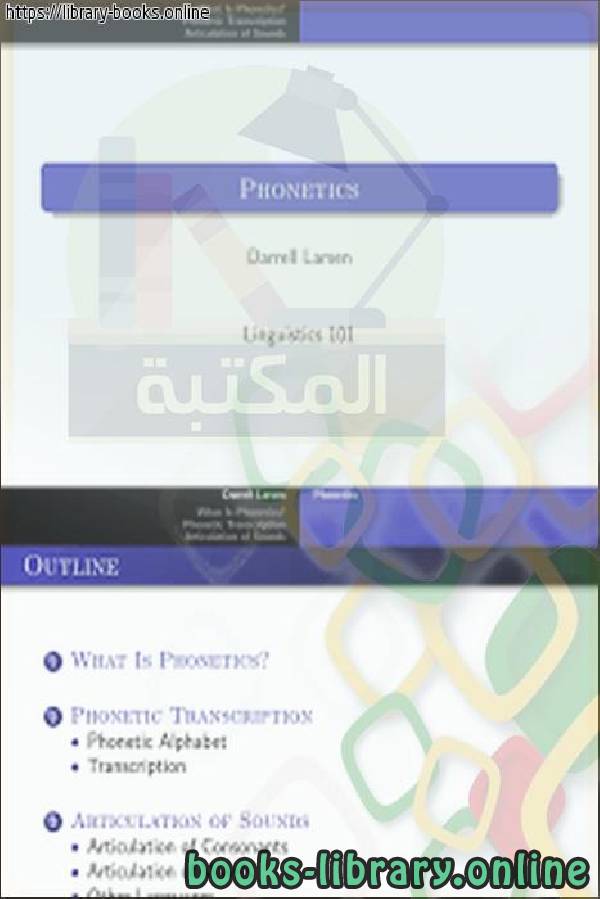
Introduction to Linguistics Darrell Larsen PDF
قراءة و تحميل كتاب Introduction to Linguistics Darrell Larsen PDF مجانا
